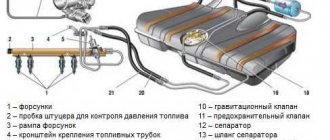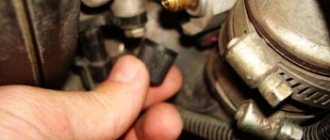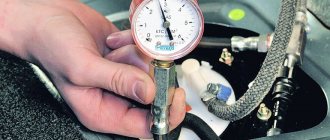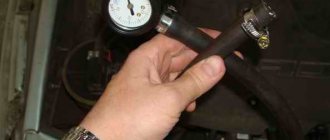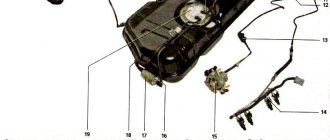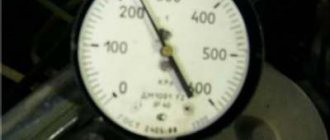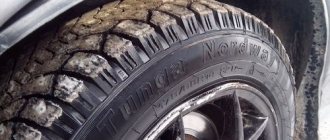Is the car jerking, loss of agility or the engine is difficult to start? One of the reasons for such malfunctions may be related to fuel pressure. Let's look at the instructions for measuring pressure in the fuel rail, as well as features that may arise during this activity.
Checking the fuel pressure is carried out similarly for all Lada cars (Granta, Kalina, Priora, Largus, Vesta, Niva 4x4 and XRAY), because All these models have the same type of engines.
The process of checking the pressure in the fuel system
You will need: an air (or preferably a water) pressure gauge, onto which you need to put a hose with a diameter of 12 mm and tighten it with a clamp. The engine should be cold and the generator covered with a rag.
Procedure:
- Unscrew the cap of the control fitting on the fuel rail (fitting). Near the timing belt (on the right in the direction of travel), or on the left near the oil filler neck (for the VAZ 21129 engine);
- Unscrew the spool from the fitting using the wheel valve cap. At this moment, due to the residual pressure in the rail, gasoline will splash out (you can first relieve the rail pressure by removing the fuse from the fuel pump with the engine running and wait until it stalls).
- We put the pressure gauge hose on the ramp fitting and secure it with a clamp;
- Turn on the ignition. The fuel pump will turn on;
- We check the readings on the pressure gauge.
What pressure should be in the fuel rail? On VAZ 2110, 14-15, 99 models it should be in the range of 2.8 - 3.2 bar. On modern engines (Priora, Granta, Kalina, Vesta, XRAY, etc.) the pressure should be 3.6–4.0 bar. The process is also shown in the video:
Device
The regulator includes two cavities - fuel and vacuum. Inside the vacuum there is a membrane that reacts to the air pressure coming from the power unit. Inside the fuel cavity there is fuel under high pressure.
The force of fuel pressure is resisted by a valve device. If the pressure is excessively high, the excess is returned back through the relief means.
This is interesting: Where is the camshaft sensor on the VAZ 2109
Troubleshooting
No pressure in the fuel rail? Causes:
- Clogged fuel filter;
- Clogged fuel pump filter;
- Fuel pump malfunction;
- Malfunction of the fuel pressure regulator (FPR). And with high blood pressure too.
If the pressure in the fuel rail gradually drops, the cause may be:
- leaking fuel pump connections;
- leaking injectors;
- fuel pump malfunction.
Let's check it like this. We clamp the leading rubber hose of the fuel rail:
- the pressure has become stable - the fuel module is leaking or the pump is faulty;
- the pressure drops - the injector(s) are leaking.
Checking the RTD. Connect the pressure gauge hose to the outlet fitting of the fuel pump and turn on the ignition:
- the pressure is low but stable - this means the RTD is faulty and is releasing pressure too intensely.
If the pressure in the fuel rail is within normal limits, we look for the causes of engine malfunctions elsewhere.
Keywords: power system Lada Granta | power supply system for Lada Kalina | power supply system for Lada Priora | power supply system for Lada Largus | 4x4 power system | power supply system for Lada Vesta | power system lada xray | Lada Granta engine | Lada Kalina engine | Lada Priora engine | Lada Largus engine | 4x4 engine | Lada Vesta engine | lada xray engine | Niva power system | Niva engine | universal article
0 0 0 0 0 0
Share on social networks:
Recommended reading
Malfunctions of the fuel system can make themselves felt in a rather unpleasant form, for example, sudden “dips” when the engine reaches a large number of revolutions.
If the car “stumbles” while accelerating or jerks while driving, etc., then this may also mean there are problems with the fuel system. A mandatory engine check in such a situation is simply necessary! Only after diagnostics can you understand where the problem lies. The text below will discuss the principle of operation of the system. I would like to say right away that there is nothing complicated here. The main task of a fuel pump, which it does an excellent job of, is pumping fuel. Excess gasoline goes back through the pressure regulator. As a rule, changes in gasoline pressure in the ramp can vary depending on pressing the gas pedal. After turning off the engine, the pressure will begin to decrease. Depending on the quality of the valve fixation, this can take from 5-10 minutes to 5-6 hours.
It is also worth remembering that in order to check the pressure during diagnostics, the following mandatory conditions must be observed - do this when the ignition is turned on, at idle, with the hose crushed and the regulator tube dropped.
If no problems arise, at XX the pressure should be within 2.5 atmospheres. Approximately 3.2-3.3 atmospheres with the RTD tube dropped. And 6.8-7.0 atmospheres if the return pipe is compressed. Indicators when pressing the gas pedal should be given special attention. During a sharp gas boost, the pressure can rise to about three atmospheres, but soon it will return to 2.3-3 atmospheres.
There is another way to check the fuel system that can help you even if you don't have a pressure gauge on hand. There is nothing complicated here either. Unscrew the hose that supplies fuel and apply voltage to the fuel pump, also do not forget to prepare some container. If about a liter and a half of gasoline comes out in about a minute, this means that everything is in order.
There is also one simple method for checking the fuel system. This is done using spark plugs. To determine the condition, you need to open the hood and carefully inspect the spark plugs. Wet spark plugs are a sure sign of fuel supply. If the spark plugs are dry, most likely fuel is not supplied, which means that it is necessary to diagnose the fuel system.
To summarize, it should be mentioned that in reality, checking the fuel pressure on a VAZ-2110 is not as difficult as you might think. But it is also worth remembering that anything can happen, so you must be prepared for any unforeseen situations.
Signs of breakdown
If for some reason the fuel pressure regulator does not perform its functions, then this can be understood by the following signs:
- The engine's operation has become unstable, it may begin to stall when idling, although it would seem that the fuel level is sufficient and all systems are in working order;
- The crankshaft at idle speed has increased or, conversely, decreased speed;
- The engine, as they say, “loses throttle response”;
- While driving, dips and jerks occur in a running engine;
- Gasoline consumption increases compared to what it was before;
- The content of CO and CH in the exhaust increases;
- The engine starts with difficulty. Although this property does not always appear.
If the regulator has become completely unusable, then an increase in fuel pressure is observed. Instead of the norm for the VAZ 2110, which ranges from 2.5 to 3.3 kg/cm2, it reaches 4 – 5 and even more.
Consequently, the fuel pump supplies more gasoline by volume, which is not completely burned, and overconsumption is guaranteed. Of course, such a regulator needs replacement, and the sooner the better.
If the fuel pressure regulator does not provide the required pressure, or simply does not hold, then the lack of fuel pressure leads to the fact that normal supply does not occur, and the VAZ 2110 “chokes” when you need to increase the speed.
In addition, the starter cannot quickly spin the engine; it has to be turned on many times.
Causes of fuel pressure regulator malfunctions
RDT may fail for several reasons. For example, defective parts are found on Russian-made cars. There are significantly fewer defects on foreign models, but you can purchase a defective RTD by purchasing a non-original spare part.
Mostly the check valve breaks down due to natural aging. Let's say this can happen after a hundred thousand mileage or more. It should be noted that check valve failures are not common. Most often, in an RTD, the membrane dries out over time, less often the valve jams, and even less often the spring breaks or weakens.
Sensor failure may occur due to low-quality gasoline. For example, in winter, fuel was filled with water, and water got into the regulator. If the fuel filter is not replaced on time, dirt gets into the parts of the power system, including the regulator. In this case, the RTD valve most often jams. It’s hard to imagine what could happen to the spring, but apparently, it still breaks sometimes.
Replacement
The procedure for replacing the fuel pressure regulator on a car like the VAZ 2110 cannot be called complicated. Therefore, do not rush to go to a service station to pay a decent amount of money. Moreover, if this is a dubious car service, it is far from a fact that they will perform the repair better than you can do it yourself.
One way or another, every VAZ 2110 car owner should know about the sequence of replacing the fuel sensor.
For this:
- Relieve the load in the fuel system;
- Remove the return mount from the fuel pressure regulator, remove the pipe;
- Unscrew the two bolts responsible for securing the unit;
- Remove the fitting;
- Remove the gasoline hose from the fuel pressure regulator;
- Remove the failed fuel sensor;
- Place a new device in its place;
- During the reassembly process, it is recommended to change the old cuffs. After their dismantling, they usually lose their original working conditions. Therefore, reusing them will not allow them to function as before.
Obviously, the fuel pressure sensor plays a vital role in the functioning of the VAZ 2110, like any other car. Its condition should be treated with increased attention, promptly respond to changes occurring, and take appropriate measures if the regulator fails.
It’s not difficult to do it yourself, and you’ll have to spend quite a bit of money. But if you are not confident in your abilities, you have no desire or simply no time to work on your own car, go to a proven, reliable car service, the quality of whose services you can be confident in. We do not recommend contacting any dubious workshops.
5. Use a 14 mm open-end wrench to tighten the hose tip.
RECOMMENDATION If necessary, the pressure in the fuel rail can be measured with a homemade device, made from a pressure gauge from a foot pump. Before connecting such a pressure gauge, the fuel pressure must be relieved (see Fuel Line - Pressure Relief). After this, unscrew the spool from the fuel rail fitting. This can be done with a metal wheel valve cap. To connect the pressure gauge to the fuel rail fitting, use a piece of gas-resistant hose of suitable diameter. The ends of the hoses must be securely secured with clamps.
6. Turn on the ignition on the car. The fuel pump will run for a few seconds. After waiting until the pump stops working, turn off the ignition. 7. To remove air from the pressure gauge, lower the end of the drain tube into a small container, unscrew the pressure gauge bleeder fitting 1/3-1/2 turn, and release excess gasoline pressure from the fuel rail. This will remove air from the pressure gauge hose.
On the VAZ 2110, the fuel pressure regulator is designed to maintain constant pressure in the fuel system in any operating mode.
The RTD is a diaphragm valve that is installed in the fuel rail. On one side, gasoline pressure is exerted on it, on the other, springs and air from the intake manifold.
